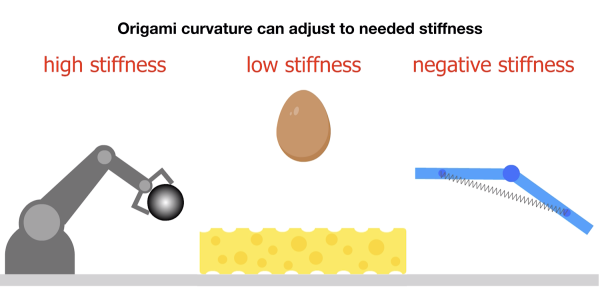Curved Origami for Robotic Flexibility

Reading Skills 1
Good readers employ a number of strategies while reading which enable them to construct and retain meaning from the text.
One of those strategies is related to visualizing and organizing, ie constructing mental images and/or using graphic organizers to organize and summarize the key points. As you read Part 1 try to visualize in your mind these two key concepts mentioned in the text:
- High flexibility / Low stiffness
- Low flexibility / High stiffness
Another reading strategy employed by good readers is summarizing/paraphrasing. In other words, restating the meaning of the text in your own words. One key concept you will read about in Part 1 is that this new technology can enable “tunable flexibility”. After reading the entirety of Part 1 imagine what tunable flexibility might look like or how that concept might work.
Part 1
Curved origami provides new range of stiffness-to-flexibility in robots
New research that employs curved origami structures has dramatic implications in the development of robotics going forward, providing tunable flexibility — the ability to adjust stiffness based on function — that historically has been difficult to achieve using simple design.
“The incorporation of curved origami structures into robotic design provides a remarkable possibility in tunable flexibility, or stiffness, as its complementary concept,” explained Hanqing Jiang, a mechanical engineering professor at Arizona State University.
“High flexibility, or low stiffness, is comparable to the soft landing navigated by a cat. Low flexibility, or high stiffness, is similar to executing of a hard jump in a pair of stiff boots,” he said.
Jiang is the lead author of a paper, “In Situ Stiffness Manipulation Using Elegant Curved Origami,” published this week in Science Advances. “Curved Origami can add both strength and catlike flexibility to robotic actions,” he said.
Jiang also compared employing curved origami to the operational differences between sporty cars sought by drivers who want to feel the rigidity of the road and vehicles desired by those who seek a comfortable ride that alleviates jarring movements.
“Similar to switching between a sporty-car mode to a comfortable-ride mode, these curved origami structures will simultaneously offer a capability to on-demand switch between soft and hard modes depending on how the robots interact with the environment,” he said.
Reading Skills 2
A third skill we can consider is inferring (guessing the meaing from context). There may be concepts and terminology which are not fully defined in the text. In this case, we can firstly infer the meaning based on the other ideas in the text, the context in general, and our previous knowledge.
Sometimes, after reading a dense text we may also want to use a dictionary or search engine to look up some of the key terms. Visuals are a great way to better understand new concepts. When reading an academic text or doing online research, always compare what you see in the diagrams, if avaialbe, to what you have read. For example, consider the diagram below. Does it confirm what you had understood about these concepts? Does it help deepen your understanding?

Go on to the next tab to read the rest of the article.
Part 2
Read the rest of the article below, and then go on to the next tab to check your understanding and use of some of the key terms in the article.
Robotics requires a variety of stiffness modes: high rigidity is necessary for lifting weights; high flexibility is needed for impact absorption; and negative stiffness, or the ability to quickly release stored energy like a spring, is needed for sprint.
Traditionally, the mechanics of accommodating rigidity variances can be bulky with nominal range, whereas curved origami can compactly support an expanded stiffness scale with on-demand flexibility. The structures covered in Jiang and team’s research combine the folding energy at the origami creases with the bending of the panel, tuned by switching among multiple curved creases between two points.
Curved origami enables a single robot to accomplish a variety of movements. A pneumatic, swimming robot developed by the team can accomplish a range of nine different movements, including fast, medium, slow, linear and rotational movements, by simply adjusting which creases are used.
In addition to applications for robotics, the curved origami research principles are also relevant for the design of mechanical metamaterials in the fields of electromagnetics, automobile and aerospace components, and biomedical devices.
“The beauty of this work is that the design of curved origami is very similar, just by changing the straight creases to curved creases, and each curved crease corresponds to a particular flexibility,” Jiang said.